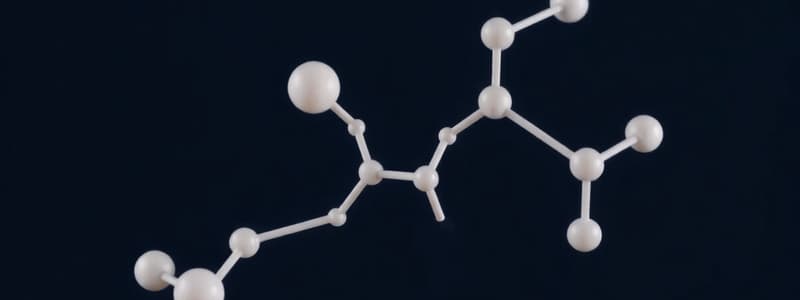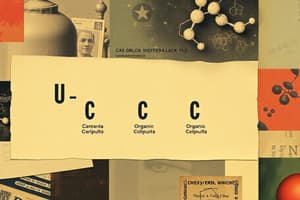Podcast
Questions and Answers
Monosaccharides can be classified into two types based on the functional group: __________ and ketoses.
Monosaccharides can be classified into two types based on the functional group: __________ and ketoses.
aldoses
In aqueous solutions, glucose can form a cyclic structure known as __________.
In aqueous solutions, glucose can form a cyclic structure known as __________.
hemiacetal
D- and L-isomers of monosaccharides are classified based on the orientation of the __________ group.
D- and L-isomers of monosaccharides are classified based on the orientation of the __________ group.
hydroxyl
The disaccharide __________ is composed of glucose and fructose linked by an α(1→2) glycosidic bond.
The disaccharide __________ is composed of glucose and fructose linked by an α(1→2) glycosidic bond.
Polysaccharides can be classified as __________ if they consist of one type of monosaccharide.
Polysaccharides can be classified as __________ if they consist of one type of monosaccharide.
Pyruvate is converted to ______ before entering the TCA cycle.
Pyruvate is converted to ______ before entering the TCA cycle.
The Pyruvate Dehydrogenase Complex requires five cofactors including thiamine pyrophosphate (TPP), lipoic acid, coenzyme A, FAD, and ______.
The Pyruvate Dehydrogenase Complex requires five cofactors including thiamine pyrophosphate (TPP), lipoic acid, coenzyme A, FAD, and ______.
During the TCA cycle, citrate is synthesized from acetyl-CoA and ______.
During the TCA cycle, citrate is synthesized from acetyl-CoA and ______.
Isocitrate is converted to α-ketoglutarate by the enzyme ______.
Isocitrate is converted to α-ketoglutarate by the enzyme ______.
Succinate dehydrogenase catalyzes the oxidation of succinate to ______, producing FADH₂.
Succinate dehydrogenase catalyzes the oxidation of succinate to ______, producing FADH₂.
Flashcards are hidden until you start studying
Study Notes
Monosaccharides
- Classified by the number of carbon atoms:
- Trioses (3 carbons)
- Tetroses (4 carbons)
- Pentoses (5 carbons, e.g., ribose)
- Hexoses (6 carbons, e.g., glucose, fructose)
- Functional groups:
- Aldoses (contain an aldehyde group, e.g., glucose)
- Ketoses (contain a ketone group, e.g., fructose)
- Exhibit chirality, allowing existence in different stereoisomers due to asymmetric carbons.
D- and L-Isomers
- Classified based on the orientation of the hydroxyl group (-OH) on the farthest asymmetric carbon from the carbonyl group.
- Most naturally occurring sugars are in D-form.
Cyclization of Monosaccharides
- In aqueous solutions, monosaccharides like glucose and fructose can cyclize:
- Aldoses form hemiacetals, often creating six-membered rings (pyranose).
- Ketoses form hemiketals, typically resulting in five-membered rings (furanose).
- Cyclization introduces an anomeric carbon with two configurations:
- Alpha (α) if the hydroxyl group on the anomeric carbon is down.
- Beta (β) if it is up.
Disaccharides
- Comprised of two monosaccharides linked by a glycosidic bond:
- Sucrose (glucose + fructose): Table sugar, α(1→2) glycosidic bond.
- Lactose (galactose + glucose): Found in milk, β(1→4) glycosidic bond.
- Maltose (glucose + glucose): Product of starch digestion, α(1→4) glycosidic bond.
Polysaccharides
- Long chains of monosaccharides linked by glycosidic bonds.
- Types include:
- Homopolysaccharides (one type of monosaccharide)
- Heteropolysaccharides (more than one type)
Pyruvate Dehydrogenase Complex (PDC)
- Converts pyruvate from glycolysis to acetyl-CoA before entering the TCA cycle.
- Involves:
- Decarboxylation: Removal of carbon from pyruvate, releasing CO₂.
- Oxidation: Electrons transferred to NAD⁺, forming NADH.
- Formation of acetyl-CoA by attaching the remaining two-carbon unit to coenzyme A.
- Composed of three enzymes and requires five cofactors: TPP, lipoic acid, CoA, FAD, and NAD⁺.
Regulation of PDC
- Inhibited by phosphorylation when energy levels are high (high ATP, NADH, and acetyl-CoA).
- Activated by dephosphorylation when energy levels are low (high ADP and pyruvate).
TCA Cycle
- A series of eight reactions that oxidize acetyl-CoA to CO₂, generating energy molecules (NADH, FADH₂, GTP).
- Key steps include:
- Citrate formation from acetyl-CoA and oxaloacetate (catalyzed by citrate synthase).
- Sequential transformations producing isocitrate, α-ketoglutarate, succinyl-CoA, succinate, fumarate, and malate.
Gluconeogenesis
- Energy-intensive process to synthesize glucose from two pyruvate molecules, requiring:
- 4 ATP, 2 GTP, 2 NADH.
- Regulated to prevent simultaneous activation of glycolysis:
- Hormonal control by insulin (inhibits), glucagon (stimulates), and cortisol (stimulates).
Glycogenolysis
- Breakdown of glycogen into glucose.
- Key steps:
- Glycogen phosphorylase cleaves glucose units into glucose-1-phosphate.
- Conversion of glucose-1-phosphate to glucose-6-phosphate by phosphoglucomutase.
- In the liver, glucose-6-phosphatase converts glucose-6-phosphate to free glucose.
Regulation of Glycogen Metabolism
- Insulin promotes glycogenesis and inhibits glycogenolysis; glucagon stimulates glycogenolysis and inhibits glycogenesis.
- Allosteric regulation via glucose-6-phosphate and AMP for glycogen phosphorylase and synthase.
Glycogen Storage Diseases
- Genetic disorders due to enzyme deficiencies affecting glycogen metabolism.
- Example: von Gierke Disease, a deficiency of glucose-6-phosphatase, causing hypoglycemia and liver glycogen accumulation.
Pentose Phosphate Pathway
- Involves interconversion of ribose-5-phosphate using transketolase and transaldolase, linking to glycolysis.
- Produces NADPH for biosynthesis and detoxification, affecting cellular function and metabolic balance.
Clinical Relevance of the Pentose Phosphate Pathway
- G6PD deficiency leads to reduced NADPH, increasing oxidative stress risk.
- Tumor cells may exhibit increased PPP activity for rapid growth support.
- Altered PPP activity can influence glucose metabolism and complications in diabetes.
Studying That Suits You
Use AI to generate personalized quizzes and flashcards to suit your learning preferences.



